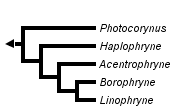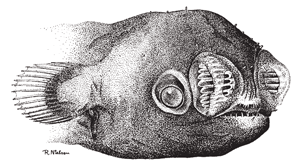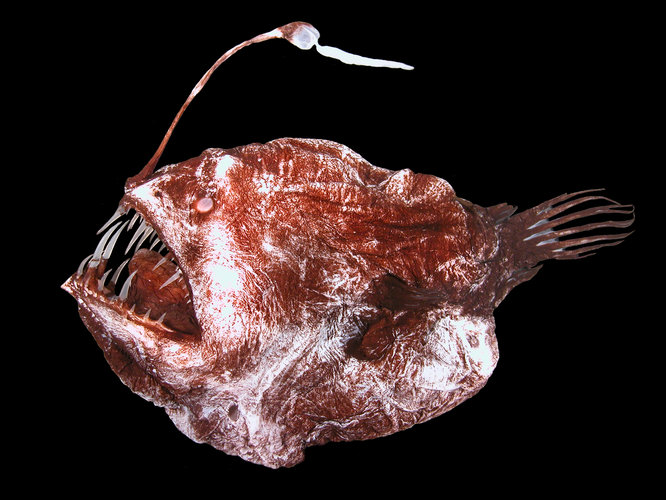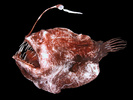Linophrynidae
Sinistral Seadevils
Theodore W. Pietsch


This tree diagram shows the relationships between several groups of organisms.
The root of the current tree connects the organisms featured in this tree to their containing group and the rest of the Tree of Life. The basal branching point in the tree represents the ancestor of the other groups in the tree. This ancestor diversified over time into several descendent subgroups, which are represented as internal nodes and terminal taxa to the right.

You can click on the root to travel down the Tree of Life all the way to the root of all Life, and you can click on the names of descendent subgroups to travel up the Tree of Life all the way to individual species.
For more information on ToL tree formatting, please see Interpreting the Tree or Classification. To learn more about phylogenetic trees, please visit our Phylogenetic Biology pages.
close boxIntroduction
Linophrynids are spectacular even among the most bizarre of their anglerfish relatives in having the largest mouths, with the longest dagger-like teeth of any fish and perhaps of any vertebrate. In addition to an elaborately adorned esca that harbors symbiotic bioluminescent bacteria, most are uniquely equipped with a complex bioluminescent chin barbel. These features, coupled with low dorsal and anal fin-ray counts, easily differentiate female linophrynids from those of all other Lophiiformes. The family consists of five genera, three of which contain only a single recognized species, while the fourth, Acentrophryne, contains two species, and the fifth, Linophryne, includes 22 species divided among three subgenera (Bertelsen, 1982:90-100).
Characteristics
Diagnosis
The family Linophrynidae differs from all other ceratioid families in having dorsal-fin rays 3 (rarely 4), anal-fin rays 3 (rarely 2 or 4), branchiostegal rays 5 (rarely 4), and a sinistral anus. Metamorphosed females are further differentiated by having the following combination of character states: supraethmoid present; frontals without ventromedial extensions, separate in most genera, meeting on the midline in Photocorynus; parietals present; sphenotics overlapped by anterolateral margin of pterotic; sphenotic spines well developed; pterosphenoid and mesopterygoid absent; metapterygoid present; hyomandibular with single head; hypohyals 2; branchiostegal rays 5 (1 + 4), rarely 4 (0 + 4); opercle bifurcate, posterior margin moderately concave; subopercle long, extremely slender, without spine or projection on anterior margin; quadrate and articular spines absent; angular produced to form a spine in some taxa; preopercle usually with one or more spines (spines absent in Acentrophryne); jaws more-or-less equal anteriorly, lower extending slightly beyond upper in same taxa; lower jaw usually with symphysial spine (absent in Linophryne subgenus Stephanophryne); postmaxillary process of premaxilla absent; anterior-maxillomandibular ligament weak to absent; pharyngobranchial I usually absent (present but rudimentary in Photocorynus); pharyngobranchials II and III well developed and toothed; pharyngobranchial IV absent; epibranchial I well developed in Photocorynus and Haplophryne, somewhat reduced in Linophryne and Borophryne; ceratobranchial V usually absent (a small rudiment present in Photocorynus); ossified hypobranchials usually absent (a single ossified hypobranchial present in Photocorynus); an ossified basibranchial present or absent; epibranchial and ceratobranchial teeth absent; epibranchial I free, not bound to wall of pharynx by connective tissue; proximal one-half of ceratobranchial I bound to wall of pharynx; distal end of ceratobranchial I free, not bound by connective tissue to adjacent ceratobranchial II; proximal one-quarter to one-half of ceratobranchials II-IV closely bound together by connective tissue, displacing gill filaments; epurals usually absent (a single small element present in Photocorynus); posterior margin of hypural plate usually deeply notched (entire in Photocorynus); pterygiophore of illicium without remnant of second cephalic spine; escal bulb and central lumen present; esca without large tooth-like denticles; posteroventral process of coracoid absent; pectoral radials 3; pelvic bones absent; pectoral-fin rays 13-19; caudal rays 9 (2 simple + 4 bifurcated + 3 simple ), the 9th very short in Photocorynus, about one-half length of eighth caudal-fin ray in all other genera; skin everywhere naked, dermal spinules absent; ovaries paired; pyloric caecae absent.
Metamorphosed males of the family Linophrynidae are further differentiated by having the following combination of character states: eyes prominent, tubular, directed anteriorly; olfactory organs relatively large, anterior nostrils well separated, but directed more-or-less anteriorly; denticles short and stout, 3-7 teeth on upper denticular, 2-13 teeth on lower denticular; pterygiophore of illicium without connection to upper denticular; fin-ray counts as given for metamorphosed females; skin naked, without dermal spinules; parasitic stages with eyes and olfactory organs somewhat degenerated; obligate sexual parasites (see Pietsch, 2005).
Larvae of the Linophrynidae are further differentiated by having the following combination of characters states: body slender, more-or-less elongate; skin very inflated; pigment on body absent or distributed along lateral margins, never on dorsal part of body; pectoral fins small, not reaching beyond dorsal and anal fins; pelvic fins absent; fin-ray counts as given for metamorphosed females; sexual dimorphism well developed, females with distinct illicial rudiment (females of Linophryne with rudiment of hyoid barbel, present as an opaque, wart-like thickening of the skin in specimens greater than about 10 mm SL); metamorphosis delayed in at least some taxa, larvae attaining lengths of 17.5-22 mm SL, specimens in metamorphosis 15-32 mm SL (Bertelsen, 1951:135, 140, figs. 90, 93; 1984:329, fig. 168C-E).
Description
Metamorphosed females with body short, more-or-less oval in shape to globular; length of head, measured from tip of snout to base of pectoral fin, 50-60% SL; snout relatively short, usually less than 20% SL; mouth large, opening horizontal or somewhat oblique, cleft extending past eye; oral valves well developed; nostrils set on rounded papillae; dentition variable among genera: Linophryne, Borophryne, and Acentrophryne with teeth long and few, arranged in several oblique longitudinal series; Haplophryne and Photocorynus with teeth shorter, more numerous, arranged in several series; epibranchial I free from wall of pharynx; epibranchials I-IV closely bound together; proximal one-half of ceratobranchial I bound to wall of pharynx; proximal one-quarter of ceratobranchial II bound to ceratobranchial III; proximal one-half of ceratobranchial III bound to ceratobranchial IV; epibranchial IV and ceratobranchial IV bound to wall of pharynx, no opening behind fourth arch; gill filaments present on full length of ceratobranchial II, distal three-quarters of ceratobranchial III, and distal one-half of ceratobranchial IV; pseudobranch absent; illicium relatively short, stem shorter than diameter of escal bulb in Haplophryne, Photocorynus, Borophryne, and several species of Linophryne, but reaching 35-40% SL in other species of Linophryne and about 70% SL in Acentrophryne; pterygiophore of illicium short, anterior end hidden beneath skin of head or slightly protruding on snout; bioluminescent hyoid barbel present in Linophryne, absent in other genera; neuromasts of acoustico-lateralis system located at tips of low cutaneous papillae, pattern of placement as described for other ceratioids (Pietsch, 1969, 1972, 1974a, 1974b).


Free-living male of Linophryne arborifera-group, 18.5 mm SL, BMNH 2004.7.5.1, showing the extremely well-developed nostrils and eyes. Drawing by R. Nielsen, after Bertelsen (1980). © 1980, R. Nielsen & E. Bertelsen
Free-living and parasitic males known for all genera, except Acentrophryne; metamorphosed free-living males with eyes relatively large (6-9% SL in diameter), more-or-less tubular and directed anteriorly, without aphakic space; olfactory organs inflated, moderately to strongly enlarged; anterior nostrils directed anteriorly; number of olfactory lamellae 3-13, but variable among genera; jaw teeth present in Photocorynus and Haplophryne, absent in Borophryne and Linophryne; upper denticular simple or with a short dorsal prolongation, not reaching tip of illicial pterygiophore, lower denticular simple or (in Haplophryne) divided into a bilateral pair; each denticular with a single series of 3-7 upper and 2-13 lower denticular teeth; sphenotic spines prominent in males of Borophryne and in Linophryne subgenus Linophryne, absent in all other taxa; hyoid barbel absent in males of all genera; skin naked, without dermal spinules; parasitic males with somewhat degenerated denticular teeth, eyes, and olfactory organs; belly greatly inflated in mature specimens.
Larvae more elongate than those of most other ceratioids, head generally about 45% SL; skin on head and body moderately inflated; pectoral fins relatively short; subdermal pigment without a dorsal group of melanophores; small rudiment of a hyoid barbel present in largest known female larvae of Linophryne; pointed sphenotic spines present in Borophryne and Linophryne subgenus Linophryne, unlike all other ceratioid larvae.
Color of metamorphosed females usually dark brown to black over entire surface of body, except for escal appendages, distal parts of escal bulb, barbel, and fin rays; skin everywhere unpigmented in Haplophryne (unlike all other metamorphosed ceratioid females); free-living males dark brown to black in Linophryne, unpigmented in remaining genera; parasitic males dark brown to black in Linophryne and Borophryne, unpigmented in Photocorynus and Haplophryne.
The largest known female of the family is a 230-mm specimen of Linophryne lucifer; several additional specimens of Linophryne are larger than 100 mm SL. The largest recorded females of the other four genera of the family range from 50 to 159: 69 mm in Photocorynus, 159 mm in Haplophryne, 105 mm in Acentrophryne, and 101 mm in Borophryne. The largest known free-living male of Photocorynus spiniceps is 9.8 mm, 15-19.5 mm maximum lengths in the other genera. The largest known parasitic males are 7.3 mm in Photocorynus, 15 mm in Haplophryne, 22 mm in Borophryne, and 30 mm in Linophryne.
Key to Metamorphosed Females of Genera of the Linophrynidae
1A. Epiotic and posttemporal spines present; preopercle with 5-6 spines (Photocorynus Regan, 1925a)1B. Epiotic and posttemporal spines absent; preopercle with 0-1 spines (go to 2)
2A. Preopercular spines with 2-5 radiating cusps; skin unpigmented; teeth small and numerous (Haplophryne Regan, 1912)
2B. Preopercular spine simple or absent; skin darkly pigmented; teeth large and few (go to 3)
3A. Preopercular spine absent (Acentrophryne Regan, 1926)
3B. Preopercular spine present (go to 4)
4A. Hyoid barbel present (Linophryne Collett, 1886)
4B. Hyoid barbel absent (Borophryne Regan, 1925b)
References
Bertelsen, E. 1951. The ceratioid fishes. Ontogeny, taxonomy, distribution and biology. Dana Rept., 39, 276 pp.
Bertelsen, E. 1980. Notes on Linophrynidae V: A revision of the deepsea anglerfishes of the Linophryne arborifer-group (Pisces, Ceratioidei). Steenstrupia, 6(6): 29–70.
Bertelsen, E. 1982. Notes on Linophrynidae VIII: A review of the genus Linophryne, with new records and descriptions of two new species. Steenstrupia, 8(3): 49–104.
Bertelsen, E. 1984. Ceratioidei: Development and relationships. pp. 325-334, In: Moser, H. G., W. J. Richards, D. M. Cohen, M. P. Fahay, A. W. Kendall, Jr., and S. L. Richardson (editors), Ontogeny and Systematics of Fishes, Spec. Publ. No. 1, Amer. Soc. Ichthy. Herpet., ix + 760 pp.
Collett, R. 1886. On a new pediculate fish from the sea off Madeira. Proc. Zool. Soc. London, 1886: 138–143.
Pietsch, T. W. 1969. A remarkable new genus and species of deep-sea anglerfish (family Oneirodidae) from off Guadalupe Island, Mexico. Copeia, 1969(2): 365–369.
Pietsch, T. W. 1972b. A second specimen of the deep-sea anglerfish, Phyllorhinichthys micractis (family Oneirodidae), with a histological description of the snout flaps. Copeia, 1972(2): 335–340.
Pietsch, T. W. 1974a. Osteology and relationships of ceratioid anglerfishes of the family Oneirodidae, with a review of the genus Oneirodes Lütken. Nat. Hist. Mus. L. A. Co., Sci. Bull., 18, 113 pp.
Pietsch, T. W. 1974b. Systematics and distribution of ceratioid anglerfishes of the genus Lophodolos (family Oneirodidae). Breviora, 425: 1–19.
Pietsch, T. W. 2005. Dimorphism, parasitism, and sex revisited: modes of reproduction among deep-sea ceratioid anglerfishes (Teleostei: Lophiiformes). Ichthyol. Res., 52: 207–236.
Regan, C. T. 1912. The classification of the teleostean fishes of the order Pediculati. Ann. Mag. Nat. Hist., Ser. 8, 9(28): 277-289.
Regan, C. T. 1925a. Dwarfed males parasitic on the females in oceanic angler-fishes (Pediculati, Ceratioidea). Proc. Roy. Soc., B, 97: 386–400.
Regan, C. T. 1925b. New ceratioid fishes from the N. Atlantic, the Caribbean Sea, and the Gulf of Panama, collected by the "Dana." Ann. Mag. Nat. Hist., Ser. 8, 8(62): 561–567.
Regan, C. T. 1926. The pediculate fishes of the suborder Ceratioidea. Dana Oceanogr. Rept. 2, 45 pp.
Title Illustrations

| Scientific Name | Linophrynidae |
|---|---|
| Specimen Condition | Dead Specimen |
| Image Use |
 This media file is licensed under the Creative Commons Attribution-NonCommercial License - Version 3.0. This media file is licensed under the Creative Commons Attribution-NonCommercial License - Version 3.0.
|
| Copyright |
© Theodore W. Pietsch

|
About This Page
Theodore W. Pietsch

University of Washington, Seattle, Washington, USA
Correspondence regarding this page should be directed to Theodore W. Pietsch at and Christopher P. Kenaley at
Page copyright © 2005 Theodore W. Pietsch
 Page: Tree of Life
Linophrynidae. Sinistral Seadevils.
Authored by
Theodore W. Pietsch.
The TEXT of this page is licensed under the
Creative Commons Attribution-NonCommercial License - Version 3.0. Note that images and other media
featured on this page are each governed by their own license, and they may or may not be available
for reuse. Click on an image or a media link to access the media data window, which provides the
relevant licensing information. For the general terms and conditions of ToL material reuse and
redistribution, please see the Tree of Life Copyright
Policies.
Page: Tree of Life
Linophrynidae. Sinistral Seadevils.
Authored by
Theodore W. Pietsch.
The TEXT of this page is licensed under the
Creative Commons Attribution-NonCommercial License - Version 3.0. Note that images and other media
featured on this page are each governed by their own license, and they may or may not be available
for reuse. Click on an image or a media link to access the media data window, which provides the
relevant licensing information. For the general terms and conditions of ToL material reuse and
redistribution, please see the Tree of Life Copyright
Policies.
- First online 06 November 2005
- Content changed 02 October 2007
Citing this page:
Pietsch, Theodore W. 2007. Linophrynidae. Sinistral Seadevils. Version 02 October 2007. http://tolweb.org/Linophrynidae/22027/2007.10.02 in The Tree of Life Web Project, http://tolweb.org/








 Go to quick links
Go to quick search
Go to navigation for this section of the ToL site
Go to detailed links for the ToL site
Go to quick links
Go to quick search
Go to navigation for this section of the ToL site
Go to detailed links for the ToL site